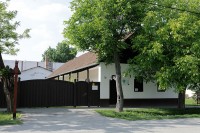PuhafÃĄbÃģl csapolt, szegelt. Baloldalon nÃĐgy fiÃģk, kÃķzÃĐpen egy ajtÃģ, felÞl hÃĄromsoros tÃĄlas polccal. Barna alapszÃnen elÃķl szÃnes virÃĄgdÃszÃtÃĐs, ÃĐlei pirosak. Az ajtÃģn felismerhetÅ a tulajdonosok neve ÃĐs a gyÃĄrtÃĄsi dÃĄtum: 1886, Johan GrÃķb Magtalena Kast.
Aus Weichholz gefertigter KÞchenschrank. Links unten sind vier Schubladen untereinander, mit runden Messingringen als Griff, unten in der Mitte eine TÞr, oben drei Tellerregale. Vor braunem Hintergrund sind vorne bunte Verzierungen: auf den Schubladen auf blauem Grund mit Blumen und Strichelmuster, auf der TÞr ist ein groÃer, durch Strichelmuster "gestreckter" Blumenstrauà in einer Kelchform mit neun groÃen Blumen, in der Mitte mit einem Herz mit Jahreszahl (1886), darunter die Namen der Inhaber: Johan GrÃķb Magtalena Kast (mit Schreibfehler). Die RÃĪnder sind rot.
en

